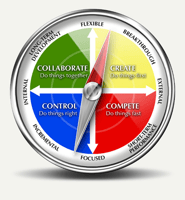Article Brief: Discover the game-changer for corporate culture: Instill's Culture Operating...
Navigating the Transition Maze: Cultivating a Culture of Success Amid Change
Transition is always happening, even when we don’t stop and acknowledge it. This month, my family is getting ready to transition our oldest child out of elementary school and into middle school, my wife is contemplating a new job opportunity, and the non-profit we help lead is discussing a massive shift in long-term strategy, to name just the big ones. In the workplace, it’s not an understatement to say that transition is a daily occurrence. New employees come in and need to be onboarded, while others transition out, leaving a hole to be filled.
Then there are the big transitions, like finding yourself at the helm of a major corporate merger. A great merger promises new horizons of possibility but also brings with it a storm of uncertainties. In the dynamic landscape of today's business world, adaptability is the compass that guides companies toward success. Navigating transitions, be they shift in leadership, strategic pivots, or technological revolutions, can be likened to exploring a maze – complex, sometimes uncertain, but rich with opportunities for growth.
Transition always means loss AND gain
One of the easiest ways we shortchange transition is by glossing over the simple fact that in any transition, no matter how great to benefit will be, something has been lost. It’s tempting as a leader to put on a smile, turn my positivity up to 11 and act like everything is great all the time. I want to maintain an air that communicates, “This transition is exactly what we all want, and nothing bad will ever be said about it!”
But I would be dead wrong. So I bring on a new teammate who is going to do amazing work and raise the level of innovation among the entire team, but that still means that the old team, the one we’re all used to and comfortable with, is changing.
Or I’m an executive managing an exciting merger that will mean more productivity, better pay, and more opportunities for everyone, but it’s also going to bring more responsibility and some shifts in the way many of my team was used to operating.
The good news is that acknowledging and discussing the dynamics of transitions is one of the best ways to help your team traverse this labyrinth effectively. Silence is really your main enemy here, so let’s look at a few creative ways to help your team start talking as they find their way through the transition maze.
Help your team put on a lens that welcomes change
Transitions, whether large or small, inevitably provoke a spectrum of emotions. Talk about the reality of transition regularly. Point out the ways you feel the loss of the “old way” so that you can more clearly point to the excitement you have in the new thing that is coming. Encourage your team to look for the loss and the gain in every transition. This new “lens” will open their eyes to be more prepared for transition and quickly identify the benefit of new changes. Crafting a culture that thrives through change demands foresight and leadership that nurtures both individuals and the team as a whole.
Building Blocks of Resilience
Resilience emerges as a cornerstone of a culture equipped for transition. Let’s face it, sometimes the maze of transition lands has you turning right into a dead-end. The only thing to do is to accept failure as a necessary part of innovation and turn down the next corridor looking for the path forward. Taking time to fortify your team with emotional intelligence, open communication, and a growth mindset will help them try new things and stay flexible in the midst of change. While it's tempting to champion unwavering stability, true strength arises from agility, enabling organizations to navigate uncharted territories while preserving their core values.
Embracing Change, One Step at a Time
If you’re leading the change your team is experiencing, then it’s important to realize that you’re going to be several steps ahead of everyone else in the transition. When I’ve led my teams through change, I have already personally grieved over whatever I’ll be losing long before taking the transition public. I already know what it’s going to cost and have weighed that with the greater benefit to be gained. Your team likely hasn’t had that opportunity. While it feels good to declare, “We made it, the transition is over!” It’s healthier to take it slow and allow each step of the process to have the time it requires. Celebrating incremental successes and fostering an environment where experimentation is welcomed can ignite a culture of continuous improvement. Learning from missteps is as valuable as celebrating victories.
Instill's Vision for Transition
In the tapestry of change, technology can play a pivotal role. That’s why at Instill, we help companies Measure, Build, and Advance the thriving culture they need to succeed. In times of change, it’s important to be able to accurately measure the current health of your work culture, build stronger systems to know the people you’re bringing on your team fit and will add to your culture in positive ways, and advance the best parts of your vision into new areas of productivity and innovation.
Instill's Culture Operating System™ acts as a compass, guiding organizations through transitions. Think of us like a maze GPS system, helping you see the obstacles and false pathways ahead so you don’t have to steer your team into dead-ends. Through AI-powered analytics, we help identify strengths and areas needing attention, enabling strategic interventions. Our platform offers the space for dialogue, insights, and growth in a rapidly changing landscape.
Unlocking the Future
Navigating transitions isn't just a task; it's an art. A canvas where resilience, leadership, collaboration, and gradual progress blend to create a masterpiece of adaptability. By cultivating a culture that thrives through change, organizations unlock a future painted with innovation, resilience, and success. Amidst the maze of transition, let your organization's culture shine as a guiding light, illuminating the path toward enduring achievement.




Blog comments